Chemical characterization of oligosaccharides in the milk of six species of New and Old World monkeys
- PMID: 21127965
- PMCID: PMC3002168
- DOI: 10.1007/s10719-010-9315-0
Chemical characterization of oligosaccharides in the milk of six species of New and Old World monkeys
Abstract
Human and great ape milks contain a diverse array of milk oligosaccharides, but little is known about the milk oligosaccharides of other primates, and how they differ among taxa. Neutral and acidic oligosaccharides were isolated from the milk of three species of Old World or catarrhine monkeys (Cercopithecidae: rhesus macaque (Macaca mulatta), toque macaque (Macaca sinica) and Hamadryas baboon (Papio hamadryas)) and three of New World or platyrrhine monkeys (Cebidae: tufted capuchin (Cebus apella) and Bolivian squirrel monkey (Saimiri boliviensis); Atelidae: mantled howler (Alouatta palliata)). The milks of these species contained 6-8% total sugar, most of which was lactose: the estimated ratio of oligosaccharides to lactose in Old World monkeys (1:4 to 1:6) was greater than in New World monkeys (1:12 to 1:23). The chemical structures of the oligosaccharides were determined mainly by (1)H-NMR spectroscopy. Oligosaccharides containing the type II unit (Gal(β1-4)GlcNAc) were found in the milk of the rhesus macaque, toque macaque, Hamadryas baboon and tufted capuchin, but oligosaccharides containing the type I unit (Gal(β1-3)GlcNAc), which have been found in human and many great ape milks, were absent from the milk of all species studied. Oligosaccharides containing Lewis x (Gal(β1-4)[Fuc(α1-3)]GlcNAc) and 3-fucosyl lactose (3-FL, Gal(β1-4)[Fuc(α1-3)]Glc) were found in the milk of the three cercopithecid monkey species, while 2-fucosyl lactose (5'-FL, Fuc(α1-2)Gal(β1-4)Glc) was absent from all species studied. All of these milks contained acidic oligosaccharides that had N-acetylneuraminic acid as part of their structures, but did not contain oligosaccharides that had N-glycolylneuraminic acid, in contrast to the milk or colostrum of great apes which contain both types of acidic oligosaccharides. Two GalNAc-containing oligosaccharides, lactose 3'-O-sulfate and lacto-N-novopentaose I (Gal(β1-3)[Gal(β1-4)GlcNAc(β1-6)]Gal(β1-4)Glc) were found only in the milk of rhesus macaque, hamadryas baboon and tufted capuchin, respectively. Further research is needed to determine the extent to which the milk oligosaccharide patterns observed among these taxa represent wider phylogenetic trends among primates and how much variation occurs among individuals or species.
Figures
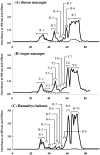
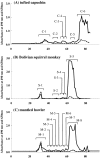
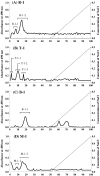
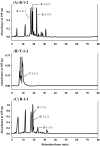
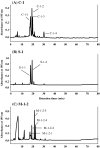
Similar articles
-
Chemical structures of oligosaccharides in milks of the American black bear (Ursus americanus americanus) and cheetah (Acinonyx jubatus).Glycoconj J. 2020 Feb;37(1):57-76. doi: 10.1007/s10719-019-09899-7. Epub 2019 Dec 11. Glycoconj J. 2020. PMID: 31828568
-
Chemical characterization of the oligosaccharides in beluga (Delphinapterus leucas) and Minke whale (Balaenoptera acutorostrata) milk.Comp Biochem Physiol B Biochem Mol Biol. 2002 Jul;132(3):611-24. doi: 10.1016/s1096-4959(02)00083-0. Comp Biochem Physiol B Biochem Mol Biol. 2002. PMID: 12091107
-
Chemical characterisation of the oligosaccharides in hooded seal (Cystophora cristata) and Australian fur seal (Arctocephalus pusillus doriferus) milk.Comp Biochem Physiol B Biochem Mol Biol. 2001 Feb;128(2):307-23. doi: 10.1016/s1096-4959(00)00327-4. Comp Biochem Physiol B Biochem Mol Biol. 2001. PMID: 11207444
-
Oligosaccharides of milk and colostrum in non-human mammals.Glycoconj J. 2001 May;18(5):357-71. doi: 10.1023/a:1014881913541. Glycoconj J. 2001. PMID: 11925504 Review.
-
Is it possible to obtain substitutes for human milk oligosaccharides from bovine milk, goat milk, or other mammal milks?Compr Rev Food Sci Food Saf. 2024 Sep;23(5):e70018. doi: 10.1111/1541-4337.70018. Compr Rev Food Sci Food Saf. 2024. PMID: 39302160 Review.
Cited by
-
Production of Lacto-N-biose I Using Crude Extracts of Bifidobacterial Cells.J Appl Glycosci (1999). 2022 May 25;69(2):15-21. doi: 10.5458/jag.jag.JAG-2021_0012. eCollection 2022. J Appl Glycosci (1999). 2022. PMID: 35891897 Free PMC article.
-
Diversity and temporal dynamics of primate milk microbiomes.Am J Primatol. 2019 Oct;81(10-11):e22994. doi: 10.1002/ajp.22994. Epub 2019 Jun 20. Am J Primatol. 2019. PMID: 31219214 Free PMC article.
-
Milk Transmission of Mammalian Retroviruses.Microorganisms. 2023 Jul 8;11(7):1777. doi: 10.3390/microorganisms11071777. Microorganisms. 2023. PMID: 37512949 Free PMC article. Review.
-
Structural characterization of neutral and acidic oligosaccharides in the milks of strepsirrhine primates: greater galago, aye-aye, Coquerel's sifaka and mongoose lemur.Glycoconj J. 2012 Apr;29(2-3):119-34. doi: 10.1007/s10719-012-9370-9. Epub 2012 Feb 4. Glycoconj J. 2012. PMID: 22311613
-
The Role of Breastfeeding in Childhood Otitis Media.Curr Allergy Asthma Rep. 2016 Sep;16(9):68. doi: 10.1007/s11882-016-0647-0. Curr Allergy Asthma Rep. 2016. PMID: 27595154 Review.
References
-
- Newburg DS, Neubauer SM. Carbohydrates in milks: Analysis, quantities and significance. In: Jensen RG, editor. Handbook of Milk Composition. San Diego: Academic; 1995. pp. 273–249.
-
- Urashima T, Asakuma S, Messer M. Milk oligosaccharides. In: Kamerling JPY, editor. Comprehensive Glycoscience. Amsterdam: Elsevier; 2007. pp. 695–724.
-
- Urashima T, Kitaoka M, Asakuma S, Messer M. Milk oligosaccharides. In: McSweeney PLH, Fox PF, editors. Advanced Dairy Chemistry, Vol. 3, Lactose, Water, Salts and Minor Constituents. New York: Springer Science + Business Media; 2009. pp. 295–349.
Publication types
MeSH terms
Substances
Grants and funding
LinkOut - more resources
Full Text Sources
Research Materials
Miscellaneous

